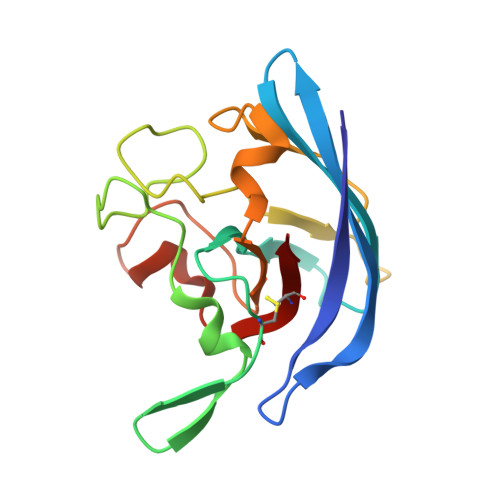Functional and crystallographic characterization of Salmonella typhimurium Cu,Zn superoxide dismutase coded by the sodCI virulence gene.
Pesce, A., Battistoni, A., Stroppolo, M.E., Polizio, F., Nardini, M., Kroll, J.S., Langford, P.R., O'Neill, P., Sette, M., Desideri, A., Bolognesi, M.(2000) J Mol Biology 302: 465-478
- PubMed: 10970746
- DOI: https://doi.org/10.1006/jmbi.2000.4074
- Primary Citation of Related Structures:
1EQW - PubMed Abstract:
The functional and three-dimensional structural features of Cu,Zn superoxide dismutase coded by the Salmonella typhimurium sodCI gene, have been characterized. Measurements of the catalytic rate indicate that this enzyme is the most efficient superoxide dismutase analyzed so far, a feature that may be related to the exclusive association of the sodCI gene with the most pathogenic Salmonella serotypes. The enzyme active-site copper ion is highly accessible to external probes, as indicated by quenching of the water proton relaxation rate upon addition of iodide. The shape of the electron paramagnetic resonance spectrum is dependent on the frozen or liquid state of the enzyme solution, suggesting relative flexibility of the copper ion environment. The crystal structure (R-factor 22.6%, at 2.3 A resolution) indicates that the dimeric enzyme adopts the quaternary assembly typical of prokaryotic Cu,Zn superoxide dismutases. However, when compared to the structures of the homologous enzymes from Photobacterium leiognathi and Actinobacillus pleuropneumoniae, the subunit interface of Salmonella Cu,Zn superoxide dismutase shows substitution of 11 out of 19 interface residues. As a consequence, the network of structural water molecules that fill the dimer interface cavity is structured differently from the other dimeric bacterial enzymes. The crystallographic and functional characterization of this Salmonella Cu,Zn superoxide dismutase indicates that structural variability and catalytic efficiency are higher in prokaryotic than in the eukaryotic homologous enzymes.
- Department of Physics-INFM and Advanced Biotechnology Center-IST, University of Genoa, Largo Rosanna Benzi, Genova, 10. I-16132, Italy.
Organizational Affiliation:


















